Related Research Articles

A space station is a spacecraft capable of supporting a human crew in orbit for an extended period of time and is therefore a type of space habitat. It lacks major propulsion or landing systems. An orbital station or an orbital space station is an artificial satellite. Stations must have docking ports to allow other spacecraft to dock to transfer crew and supplies. The purpose of maintaining an orbital outpost varies depending on the program. Space stations have most often been launched for scientific purposes, but military launches have also occurred.

The Soyuz programme is a human spaceflight programme initiated by the Soviet Union in the early 1960s. The Soyuz spacecraft was originally part of a Moon landing project intended to put a Soviet cosmonaut on the Moon. It was the third Soviet human spaceflight programme after the Vostok (1961–1963) and Voskhod (1964–1965) programmes.

Mir was a space station that operated in low Earth orbit from 1986 to 2001, operated by the Soviet Union and later by Russia. Mir was the first modular space station and was assembled in orbit from 1986 to 1996. It had a greater mass than any previous spacecraft. At the time it was the largest artificial satellite in orbit, succeeded by the International Space Station (ISS) after Mir's orbit decayed. The station served as a microgravity research laboratory in which crews conducted experiments in biology, human biology, physics, astronomy, meteorology, and spacecraft systems with a goal of developing technologies required for permanent occupation of space.

The Salyut programme was the first space station programme, undertaken by the Soviet Union. It involved a series of four crewed scientific research space stations and two crewed military reconnaissance space stations over a period of 15 years, from 1971 to 1986. Two other Salyut launches failed. In one respect, Salyut had the task of carrying out long-term research into the problems of living in space and a variety of astronomical, biological and Earth-resources experiments, and on the other hand the USSR used this civilian programme as a cover for the highly secretive military Almaz stations, which flew under the Salyut designation. Salyut 1, the first station in the programme, became the world's first crewed space station.

The Space Race was a 20th-century competition between two Cold War rivals, the United States and the Soviet Union, to achieve superior spaceflight capability. It had its origins in the ballistic missile-based nuclear arms race between the two nations following World War II and had its peak with the more particular Moon Race to land on the Moon between the US moonshot and Soviet moonshot programs. The technological advantage demonstrated by spaceflight achievement was seen as necessary for national security and became part of the symbolism and ideology of the time. The Space Race brought pioneering launches of artificial satellites, robotic space probes to the Moon, Venus, and Mars, and human spaceflight in low Earth orbit and ultimately to the Moon.

Soyuz is a series of spacecraft which has been in service since the 1960s, having made more than 140 flights. It was designed for the Soviet space program by the Korolev Design Bureau. The Soyuz succeeded the Voskhod spacecraft and was originally built as part of the Soviet crewed lunar programs. It is launched on a Soyuz rocket from the Baikonur Cosmodrome in Kazakhstan. Between the 2011 retirement of the Space Shuttle and the 2020 demo flight of SpaceX Crew Dragon, the Soyuz served as the only means to ferry crew to or from the International Space Station, for which it remains heavily used. Although China did launch crewed Shenzhou flights during this time, none of them docked with the ISS.

PAO S. P. Korolev Rocket and Space Corporation Energia, also known as RSC Energia, is a Russian manufacturer of spacecraft and space station components. The company is the prime developer and contractor of the Russian crewed spaceflight program; it also owns a majority of Sea Launch. Its name is derived from Sergei Korolev, the first chief of its design bureau, and the Russian word for energy.
Human spaceflight programs have been conducted, started, or planned by multiple countries and companies. The age of manned rocket flight was initiated by Fritz von Opel who piloted the world's first rocket-propelled flight on 30 September 1929. All space flights depend on rocket technology; von Opel was the co-designer and financier of the visionary project. Until the 21st century, human spaceflight programs were sponsored exclusively by governments, through either the military or civilian space agencies. With the launch of the privately funded SpaceShipOne in 2004, a new category of human spaceflight programs – commercial human spaceflight – arrived. By the end of 2022, three countries and one private company (SpaceX) had successfully launched humans to Earth orbit, and two private companies had launched humans on a suborbital trajectory.
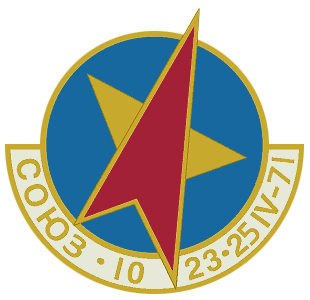
Soyuz 10 was launched on 22 April 1971 as the world's first mission to the world's first space station, the Soviet Salyut 1. The docking was not successful and the crew, Vladimir Shatalov, Aleksei Yeliseyev, and Nikolai Rukavishnikov, returned to Earth without having entered the station. Following difficulties in docking pairs of Soyuz capsules, this would be the first of numerous docking failures in the Soviet space station program.
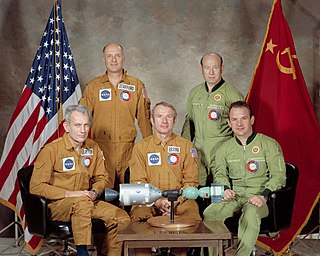
Apollo–Soyuz was the first crewed international space mission, carried out jointly by the United States and the Soviet Union in July 1975. Millions of people around the world watched on television as a United States Apollo spacecraft docked with a Soviet Soyuz capsule. The project, and its handshake in space, was a symbol of détente between the two superpowers during the Cold War.

Gennady Mikhailovich Strekalov was an engineer, cosmonaut, and administrator at Russian aerospace firm RSC Energia. He flew into space five times and lived aboard the Salyut 6, Salyut 7, and Mir space stations, spending over 268 days in space. The catastrophic explosion of a Soyuz rocket in 1983 led to him being one of only four people to use a launch escape system. He was decorated twice as Hero of the Soviet Union and received the Ashoka Chakra from India.
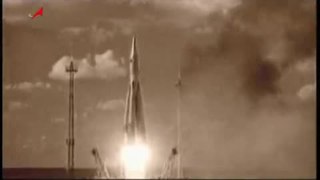
The Soviet space program was the national space program of the former Union of Soviet Socialist Republics (USSR), active from 1955 until the dissolution of the Soviet Union in 1991.

The Shuttle–Mir program was a collaborative 11-mission space program between Russia and the United States that involved American Space Shuttles visiting the Russian space station Mir, Russian cosmonauts flying on the Shuttle, and an American astronaut flying aboard a Soyuz spacecraft to engage in long-duration expeditions aboard Mir.
The Soviet crewed lunar programs were a series of programs pursued by the Soviet Union to land humans on the Moon, in competition with the United States Apollo program. The Soviet government publicly denied participating in such a competition, but secretly pursued two programs in the 1960s: crewed lunar flyby missions using Soyuz 7K-L1 (Zond) spacecraft launched with the Proton-K rocket, and a crewed lunar landing using Soyuz 7K-LOK and LK spacecraft launched with the N1 rocket. Following the dual American successes of the first crewed lunar orbit on 24–25 December 1968 and the first Moon landing on July 20, 1969, and a series of catastrophic N1 failures, both Soviet programs were eventually brought to an end. The Proton-based Zond program was canceled in 1970, and the N1-L3 program was de facto terminated in 1974 and officially canceled in 1976. Soviet cosmonauts never orbited nor landed on the Moon. Details of both Soviet programs were kept secret until 1990 when the government allowed them to be published under the policy of glasnost.

The terms Androgynous Peripheral Attach System (APAS), Androgynous Peripheral Assembly System (APAS) and Androgynous Peripheral Docking System (APDS) are used interchangeably to describe a Russian family of spacecraft docking mechanisms, and are also sometimes used as generic names for any docking system in that family. A system similar to APAS-89/95 is used by the Chinese Shenzhou spacecraft.

The Soviet Union planned several military Soyuz spacecraft models. These versions were named Soyuz P, Soyuz PPK, Soyuz R, Soyuz 7K-VI, and Soyuz OIS . However, none ever flew in space.

Docking and berthing of spacecraft is the joining of two space vehicles. This connection can be temporary, or partially permanent such as for space station modules.
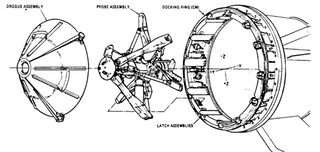
The docking mechanism of the Apollo was a "probe and drogue" system designed to allow the Apollo Command/Service Module (CSM) to dock with the Apollo Lunar Module. The same system was later used for the Skylab 2, Skylab 3 and Skylab 4 CSMs to dock with the Skylab space station, and the Apollo–Soyuz Test Project CSM to dock with a Docking Module adapter which allowed docking with the Soyuz 19 spacecraft. There were 12 hard latches.
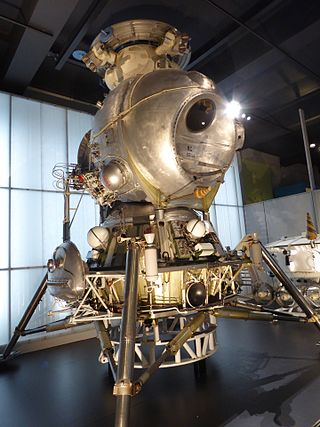
Soyuz Kontakt(Soyuz Contact) was the docking hardware of the Soviet crewed lunar spacecraft program. The Soviet lunar human program was canceled in 1974 after many failures. Four failures of the N-1 Rocket super heavy-lift launch vehicle and the success of the U.S. Apollo program ended the Soviet crewed moon program.
References
"Vladimir Syromyatnikov", The Daily Telegraph , 9 Oct 2006
- Interview in the IEEE Spectrum, April 2006
- "S. P. Korolev. Encyclopedia of life and creativity" - edited by C. A. Lopota, RSC Energia. S. P. Korolev, 2014 ISBN 978-5-906674-04-3